 |
|

|
 |
TABLE of CONTENTS
|
Governor, commissioner: Investing in transportation is key to Minnesota's economy, quality of life |
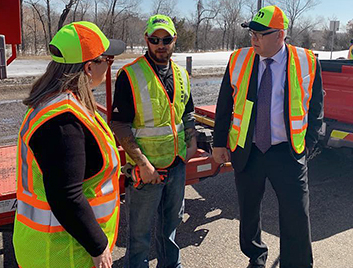
Sheila Kauppi, Metro District North Area manager, and Dan Backsen, Anoka Truck Station supervisor, talk potholes with Gov. Tim Walz March 19 along Hwy 47 in Anoka as part of the administrationís transportation funding outreach. Photo courtesy of the Office of Governor |
Gov. Tim Walz, Lt. Gov. Peggy Flanagan and Commissioner Margaret Anderson Kelliher joined local elected officials in Anoka March 19 to talk about the need to invest in Minnesota’s infrastructure. They highlighted the governor’s transportation budget proposal and the list of projects it would enable, including improving the at-grade railway crossing at Hwy 47 and Ferry Street in Anoka.
The intersection, which has more than 18,000 vehicles and up to 80 trains cross daily, has been a safety concern for years with major crashes dating back to 1972. In 2003, a teen driver collided with a train, resulting in four fatalities. This project, like many included in the candidate list of more than 500 projects that could be funded with additional revenue, is critical to improving safety and helping traffic move faster and more efficiently in the area.
“At the [Hwy 47 and Ferry Street] intersection we visited today, there were 17 car accidents in four years,” said Walz in a news release issued by his office. “We’re talking about 17 car accidents in just 150 feet. That’s no coincidence. This is not safe, and it’s not unique to Anoka. Communities across the state need help fixing dangerous conditions like these.
“Let’s be clear: This isn’t a choice between whether we want a gas tax or not,” he said. “It’s a choice between ensuring Minnesota has a 21st century transportation system or allowing conditions to further deteriorate and risk our safety.”
Anderson Kelliher noted that the state’s economy and quality of life depends on Minnesotans’ ability to get where they need to go safely and efficiently.
"Gov. Walz’s budget proposal truly reflects his One Minnesota vision by providing comprehensive and dependable funding Minnesotans can count on to fix our existing infrastructure and invest in the future," she said.
For more information about the governor’s transportation budget proposal, see the March 19 news release and transportation funding website.
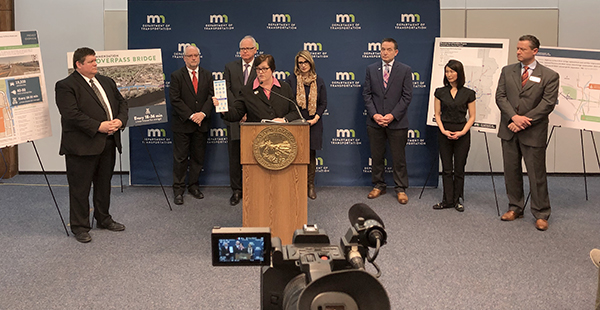
Participants in the March 19 news conference in Anoka are: (left to right) Greg Lee, Anoka city manager; Mike Gamache, Anoka County commissioner; Gov. Tim Walz; MnDOT Commissioner Margaret Anderson Kelliher; Lt. Gov. Peggy Flanagan; Mayor John LeTourneau, city of Ramsey; Mandy Meisner, Anoka County commissioner; and Matt Look, Anoka County commissioner. Photo by Kristi Loobeek |
|
 |
|

|
 |
TABLE of CONTENTS
 |
Crews shift from snow removal to challenges of spring flooding |
By Rich Kemp
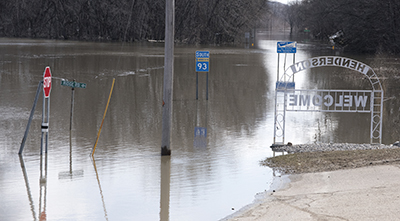
Flooding of the Minnesota River caused MnDOT to closed Hwy 93 near Henderson. Photo by Rich Kemp |
The record-setting snow that came in February is melting and causing flooding in the southern half of the state. Several roads have closed in District 6 and District 7.
“January, February and March have been extremely challenging for our crews, with all the snow, then the rain and now flooding,” said Jed Falgren, District 7 assistant district engineer. "With full ditches and catch basins blocked by snow piles, significant flooding quickly became a challenge. We had employees dealing with snow and ice removal, flooding and patching potholes all in the span of a day or two. It was exciting to see how our employees stepped up to meet the challenge.”
Current road closures:
- Hwy 19 east of Henderson - closed March 19
- Hwy 41 between Hwy 169 and Chaska – closed March 21
- Hwy 60 at Hwy 61 in Wabasha - closed March 12
- Hwy 65 in Albert Lea closed March 20
- Hwy 74 between Beaver and Weaver – closed March 14
- Hwy 75 south of Madison – closed March 25
- Hwy 93 south of Henderson – closed March 16
- Hwy 93 between Hwy 169 and Le Sueur - closed March 20
- Hwy 99 Minnesota River bridge in St. Peter - closed March 20
Roads re-opened:
- Hwy 4 north of St. James – closed March 17, opened March 21
- Hwy 13 south of Waseca closed - March 14, opened March 15
- Hwy 16 south of Lanesboro closed March 14, opened March 15
- Hwy 30 east of Mapleton – closed March 16, opened March 17 to one lane
- Hwy 75 from Iowa border to I-90 closed - March 14, opened March 15
- Hwy 75 north of I-90 to Trosky – closed March 14, opened March 18
District 8 has one road (Hwy 75) closed and District 4 has worked to avoid road closures in the northwestern part of the state.
“We’ve had some water on the road in various places, but crews have been able to get it re-channeled back into the ditches and off the roadway pretty quickly,” said Emma Olson, District 4 public affairs coordinator.
MnDOT cautions motorists:
- Do not drive around barricades or into flooded areas.
- Six inches of water will reach the bottom of most passenger cars, causing loss of control and possible stalling. A foot of water will float many vehicles. Two feet of rushing water can carry away most vehicles including sport utility vehicles and pick-ups.
- When a road is closed it is illegal to travel in that area. Motorists can be fined up to $1,000 and/or 90 days in jail. If travelers need to be rescued from a closed road, other expenses and penalties will also apply.
Check www.511mn.org before traveling for information on road conditions, closures and detour routes. For additional updates, ‘like’ MnDOT at www.facebook.com/mndot, and follow @mndotnews on Twitter.
This drone video shows flooding of the Minnesota River over Hwy 93 going into Le Sueur in south central Minnesota. Video produced by Kristi Loobeek |
|
 |
|

|
 |
TABLE of CONTENTS
 |
Mississippi River flooding could affect opening of shipping season |
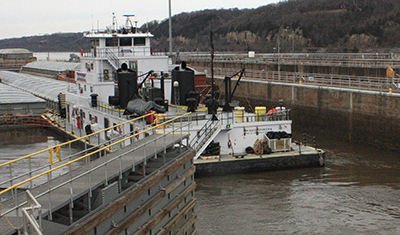
Motor vessel Michael Poindexter passed through Lock and Dam 2 in Hastings to start the 2018 Upper Mississippi shipping season. The 2019 shipping season could be delayed because of flooding. Photo by Patrick Phenow |
By Sue Roe
Flooding could affect the opening of the Mississippi River shipping season, according to Patrick Phenow, ports and waterways program coordinator.
The shipping season usually opens around this time in March, although it’s opened as early as March 4. The latest arrival of barges into the Twin Cities unrelated to flooding was April 8, 2013. Historic flooding in 2001 delayed the arrival of the first tow until May 11.
The opening is determined by the depth of the ice on Lake Pepin in southeast Minnesota. Phenow said the lake will be measured again this week by the Army Corp of Engineers.
Several locks downstream are still closed, starting with Dubuque, Iowa and into Illinois, but Phenow said barges could be coming north around the middle of April.
“Right now, the flooding is putting a pinch on some commodities, such as cement and fertilizer,” he said. |
 |
|

|
 |
TABLE of CONTENTS
 |
Transportation conference focuses on safety, security issues |
By Sue Roe
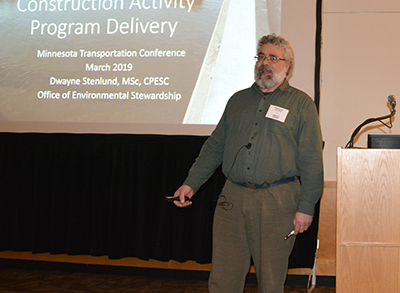
Dwayne Stenlund, Environmental Stewardship, presents information about how MnDOT mitigates climate risk into its construction projects. Photo by Sue Roe |
Safety and security issues facing the transportation industry highlighted the 2019 Transportation Conference March 13-14 in St. Paul. As technology rapidly transforms the transportation system, focusing on safety and security is relevant as the conversation continues to revolve around funding, technology and innovation.
Commissioner Margaret Anderson Kelliher welcomed the 1,000 participants to the conference. Keynote speaker John Sileo spoke about cyber security and how to address the technological and human elements of data defense. His presentation focused on decision making, cyber defense, mobile technology, social media and cloud computing.
“The transportation conference was well attended and the keynote speakers were well received," said Brad Hamilton, engineering services, who serves on the planning committee. “It’s a good opportunity to connect and learn from our industry partners. The conference is the one event in the state that has all the transportation sectors under one roof.”
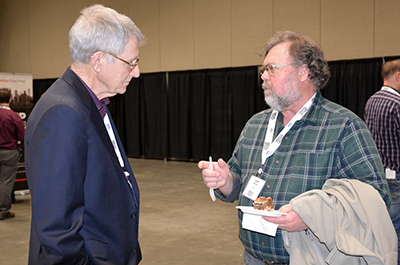
Kent Medalen, District 8, right, talks with Alan Goodman of MSA Professional Services, during the transportation conference. Photo by Sue Roe |
The conference featured 35 sessions on topics such as big data, diversity, connected and automated vehicles, asset management, mega projects, partnerships, legislative issues and multi-modal systems and facilities.
A panel session on the FAST Act, which expires in 2020, kicked off Thursday’s session. National transportation organizations are developing and presenting legislative recommendations on behalf of state DOTs and the transportation industry. Panel members said support is needed to get a new bill passed on time, which would support a new multi-year surface transportation authorization.
Thursday’s keynote speaker was Ellie Krug, whose presentation was “Bridging Divides: Fear, Grit, Resiliency and the Four Commonalities.” She talked about bridging the divide between the “us” and “them” that seems to pervade the country today. She said that bridging those divides takes honesty, mindfulness, fearlessness, compassion and hard work.
About 50 MnDOT employees presented during the concurrent sessions, covering a range of topics from equity and diversity, transit, bicycle and pedestrian planning and safety, Twin Ports Interchange, transportation funding, shared mobility, Corridors of Commerce, airports, 3D visualization technology, ABC Parking Ramps, STEM education and outreach, incorporating climate risk into construction and environmentally sustainable design.
MnDOT is one of the organizations that work year-round to plan the annual conference. Next year’s conference will be in St. Paul. |
 |
|

|
 |
TABLE of CONTENTS
 |
District 3 employees create safety video |
|
District 3 employees worked with Video Services to create a video called "Why I Work Safely." The video highlights several safety issues that have occurred in the past few years in District 3. The employees made the video in the hopes that it will influence others to work safely. Video produced by Joel Wenz, Video Services |
|
 |
|

|
 |
TABLE of CONTENTS
 |
Report shows falls are #1 cause of MnDOT workplace injury claims |
By Sue Roe
Ways to prevent a slip, trip or fall
- Clean up all spills quickly, report spills that cannot easily be cleaned up to building services staff
- Use handrails whenever you use stairs
- Use three points of contact when entering or exiting equipment/vehicles
- Keep walkways, aisles and stairs clear of obstructions
- Cover or tape down cables/cords that run through walkways
- Close drawers and cabinets
- When possible, stay on shoveled walkways
- Wipe your shoes on mats when entering a building
- Wear shoes with non-skid soles and flat heels for good traction
|
In February, Peter Traxler, a transportation generalist from the Gaylord Truck Station in District 7 was walking from the main building to the salt shed when he slipped on the ice and fell.
“It was as simple as that,” he said. “I came down hard on my elbow and shoulder.”
Falls are the number one cause of MnDOT’s workplace injury claims. In 2018, 47 falls were reported that resulted in workers’ compensation claims. Those claims cost the agency $441,913.
In Traxler’s case, a few hours after his fall, he went to urgent care to get his elbow and shoulder checked out and received medical treatment.
MnDOT averages 230 accepted claims per year in the past six years for all types of injuries, although the number has been as high as 295, according to the FY 2018 Workers’ Compensation Year End Report. That averages out to about one injury per work day, according to Sue Kielty, workers’ compensation manager.
The MnDOT statewide workers’ compensation claim rate in 2018 was 4.8 injuries per 100 employees, which Kielty said is still too high.
“If we can get to the root cause of injuries, that would help reduce them,” she said. “This is where our safety culture comes into play. Prevention is important and one of the ways to significantly impact the numbers.”
Workers’ Comp injury claims
- Most costly body part for injury claims – shoulders
- Most frequently injured body part – fingers
- Most costly nature of injury claims – sprains/strains
- Top two causes of injury claims – falls, overexertion
- Top sources of injury claims – objects and ground
- Jobs with most claims – transportation generalist series
|
Between fiscal years 2012 and 2018, workers’ compensation cost averages for the agency were $3.9 million. In FY 2018, even though claims decreased, costs increased. Those costs include ongoing medical treatment such as physical therapy, diagnostics, surgery and benefits paid for recovery time away from work.
There are also indirect costs associated with workplace injuries, including lost productivity, incident investigation costs, accommodations that are made for the injured/disabled worker, loss of goodwill, emotional impact for the injured worker and loss of morale. Those costs aren’t tracked.
“Every injury that happens is tied to a person. There’s a real impact not only to the workplace, but to the injured workers’ personal life and their family when there’s an injury,” Kielty said.
Sixty percent of the 391 injury claims in 2018 were from lost time and medical-only injury claims. Total claim cost was $1.13 million.
The other 40 percent were reported as incident only, meaning the injury claim was reported, but not submitted for a decision on compensation.
That was the case with Rachel Knutson, materials management specialist at Central Office. In February, she was walking to the parking lot after work and slipped on the ice. She came down on her left knee.
“I had a little cut and bruised my knee, causing me to limp for a bit,” she said. “It wasn’t that serious and I didn’t miss any work.”
Still, Knutson reported the incident because it happened in a state parking lot.
“It’s better to be safe than sorry. You don’t always know if it’s going to become an issue later on,” she said.
Kielty said the MnDOT workers’ compensation program policy is for employees to report all injuries.
“We don’t have a crystal ball for how injuries play out,” she said. “What might be a minor injury for you and me might be more significant for somebody else.”
The FY 2018 Workers’ Compensation Year End Report will be online soon. This website also has injury forms, information about the Nurseline and training and resource materials. |
 |
|

|
|

|
|
| |
|



